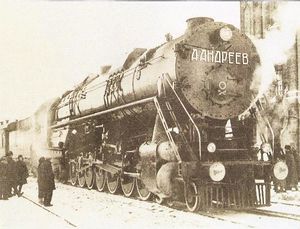4-14-4
A 4-14-4, in the Whyte notation for the classification of steam locomotives by wheel arrangement, is a locomotive with four leading wheels in a leading truck, fourteen driving wheels (seven axles) in a rigid frame, and four trailing wheels in a trailing truck. The equivalent UIC classification is 2'G2'.
A single example of this type, called the AA20-1, was built by the Soviet Union. The designation stands for Andrei Andreev (who sponsored its construction), 20 ton axle load. While some builders had produced twelve-coupled (six driving axles) designs, no one had ever built a fourteen-coupled engine. The AA20-1 holds two records: the largest number of coupled axles on a locomotive, and being the longest rigid frame locomotive in Europe. It was the largest rigid frame locomotive in the world until 1939, when the PRR S1 was unveiled.
The large number of driving axles were meant to spread out the locomotive's weight, reducing the axle load and the resulting stress on the track. A group of Soviet locomotive engineers had visited the United States, and presumably they had seen the 4-12-2 locomotives being used by the Union Pacific. The 4-14-4 could be viewed as an expansion of that type. Unlike the successful Union Pacific locomotives, however, the AA20-1 was a complete disaster.
The AA20-1 was originally intended to be a 2-14-4 (1'G2'). Construction was undertaken in Essen, Germany by Krupp, following a Soviet design. Later, the unfinished locomotive was moved to Lugansk, where a two-axle leading truck was fitted. The trailing truck supported a huge firebox. The AA20-1 was intended to run on low-quality coal, so a lot of space was needed to burn it in order to provide enough heat to the boiler.
The seven driving axles made for a very long rigid wheelbase, and provisions were made to negotiate curves. The center three driving axles were blind, allowing some sideways movement over the railhead. The side rods connecting the first and second and sixth and seventh axles had universal joints. These measures were not enough to make the AA20-1 work properly, however. It was prone to frequent derailments, and despite its large number of wheels, it was still too heavy for the track. As a result of its long wheelbase, the AA20-1 also spread the track and wrecked the points of the switches it passed over. It was too big to fit on the turntables, too powerful for the couplers in use at the time and unable to run at full power for very long due to its undersized boiler.
The AA20-1 made a publicity trip to Moscow in 1935. It was then put into storage and secretly scrapped. Its fate would remain a mystery for nearly thirty years.
External link
Steam locomotive types | |
|---|---|
| Single engine types | 0-2-2 • 2-2-0 • 2-2-2 • 2-2-4 • 4-2-0 • 4-2-2 • 4-2-4 • 6-2-0 0-4-0 • 0-4-2 • 0-4-4 • 2-4-0 • 2-4-2 • 2-4-4 • 4-4-0 • 4-4-2 • 4-4-4 0-6-0 • 0-6-2 • 0-6-4 • 2-6-0 • 2-6-2 • 2-6-4 • 2-6-6 • 4-6-0 • 4-6-2 • 4-6-4 0-8-0 • 0-8-2 • 0-8-4 • 2-8-0 • 2-8-2 • 2-8-4 • 2-8-6 • 4-8-0 • 4-8-2 • 4-8-4 • 4-8-6 • 6-8-6 0-10-0 • 0-10-2 • 2-10-0 • 2-10-2 • 2-10-4 • 4-10-0 • 4-10-2 0-12-0 • 2-12-0 • 2-12-2 • 2-12-4 • 4-12-2 • 4-14-4 |
| Duplex engine types | 4-4-4-4 • 6-4-4-6 • 4-4-6-4 • 4-6-4-4 |
| Garratt (articulated) types | 0-4-0+0-4-0 • 2-6-0+0-6-2 • 4-6-2+2-6-4 • 2-8-0+0-8-2 • 4-8-2+2-8-4 • 4-8-4+4-8-4 |
| Mallet (articulated) types | 0-4-4-0 • 0-4-4-2 • 2-4-4-2 0-6-6-0 • 2-6-6-0 • 2-6-6-2 • 2-6-6-4 • 2-6-6-6 • 2-6-8-0 • 4-6-6-2 • 4-6-6-4 0-8-8-0 • 2-8-8-0 • 2-8-8-2 • 2-8-8-4 • 4-8-8-2 • 4-8-8-4 2-10-10-2 • 2-8-8-8-2 • 2-8-8-8-4 |

